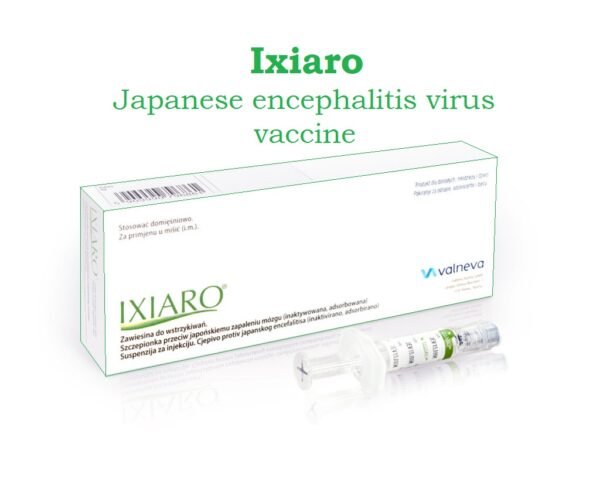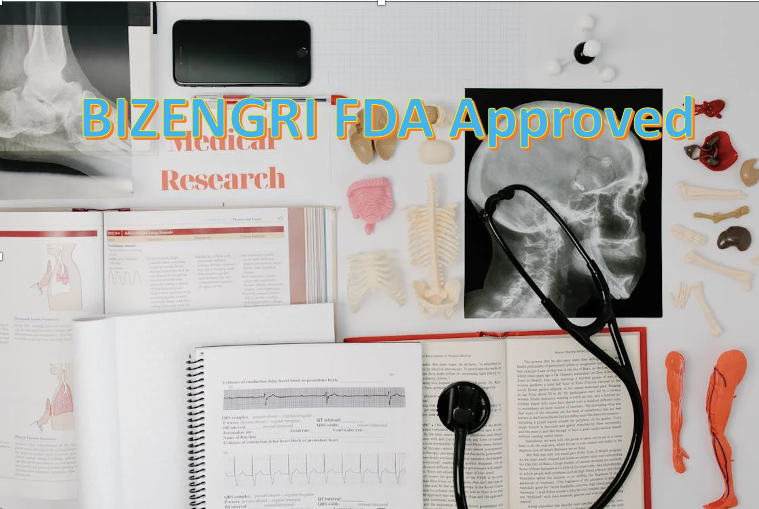Ixiaro (Japanese encephalitis virus vaccine) is an inactivated vaccine manufactured by Valneva SE. It is administered intramuscularly for the prevention of disease caused by JEV (Japanese Encephalitis Virus).
Ixiaro (Japanese encephalitis virus vaccine) Uses:
-
Japanese encephalitis prevention:
- For people under the age of two months, it is used in the active vaccination against Japanese encephalitis (JE).
-
The Advisory Committee on Immunization Practices (ACIP) recommends vaccination for (CDC/ACIP [Hills 2019]):
- People moving to or frequently traveling to JE-endemic areas
- The ones spending ≥1 month in endemic areas
- Especially those working in laboratories who might come into contact with JE viruses other than the SA14-14-2 JE vaccination virus For people handling high concentrations, large volumes, or the transmission of the SA14-14-2 JE virus, immunisation should be taken into consideration.
Note: It should be emphasised that employees handling standard clinical samples are not needed to be immunised.
-
-
- Short-term (i.e., less than one month) travellers who are more likely to contract JE due to the length of their trip, the time of year they travel, where they will be staying, what they will do while there, or if their travel plans are unsure should think about becoming immunised.
-
Note: For very low-risk travellers, it is not advised (e.g. those travelling for shorter terms and only to urban areas or periods outside of the well-defined JE virus transmission season).
Ixiaro (Japanese encephalitis virus vaccine) Dose in Adults:
Ixiaro (Japanese encephalitis virus vaccine) Primary immunization:
-
Adults ≤65 years:
- 0.5 mL/dose IM;
- a total of 2 doses given on days 0 and 7 to 28.
- One week before a prospective exposure, the series must be finished.
Ixiaro (Japanese encephalitis virus vaccine) Booster dose:
- 0.5 mL/dose IM administered 1 year after the initial immunisation series is finished in the event that exposure to Japanese encephalitis is ongoing or anticipated (CDC/ACIP [Hills 2019]).
Note:
- Limited data from a single clinical research in adults showed that when the second dosage was given 11 months after the first dose, there was a 99% seroconversion rate if the second dose was omitted.
Ixiaro (Japanese encephalitis virus vaccine) Dose in Childrens:
Ixiaro (Japanese encephalitis virus vaccine) Primary immunization:
Note: It is said that the series needs to be finished at least a week before it might be exposed.
-
ACIP/CDC Recommendations (CDC/ACIP [Hills 2019]):
- Infants 2 months to Children ≤35 months:
- 0.25 mL/dose IM on days 0 and 28 for a total of 2 doses.
- Children ≥3 years (36 months) and Adolescents ≤17 years:
- 0.5 mL/dose IM on days 0 and 28 for a total of 2 doses.
- Adolescents ≥18 years:
- 0.5 mL/dose IM, divided into 2 doses, with dosage 1 given on day 0 and dose 2 given at any time between days 7 and 28;
- The second dose may be given as soon as seven days following the first.
- Infants 2 months to Children ≤35 months:
Ixiaro (Japanese encephalitis virus vaccine) Booster dose, for patients with ongoing or expected reexposure:
-
Children <3 years:
- 0.25 mL/dose administered IM ≥1 year after primary immunization series completed; though there is no efficient data on booster doses administered >2 years after series completion.
-
Children ≥3 years and Adolescents:
- 0.5 mL/dose IM administered ≥1 year after primary immunization series completed; however, there is no efficacy data on booster doses administered >2 years after series completion.
Ixiaro Pregnancy Risk Category: B
- There is little information on the results of unintentional pregnant exposure to the Japanese encephalitis virus vaccine (JE) (WHO 2015).
- Pregnancy should not be considered a reason to delay vaccination.
- Pregnant women are more susceptible to infection.
- There has been intrauterine transmission of JE virus to women.
- Miscarriages have been reported in those who were infected in the first or second trimester.
Breastfeeding is a good time to get the Japanese Encephalitis Virus vaccine.
- If the vaccination is present in breast milk is unknown.
- The manufacturer advises considering the dangers to newborns, the advantages to the infant, and the mother's health before deciding whether to continue or discontinue breastfeeding following immunisation.
- Neither the mother nor the child should have their nursing safety jeopardised by the use of inactivated vaccinations.
Ixiaro (Japanese encephalitis virus vaccine) Dose in Kidney Disease:
In this category, there are no dosage adjustments provided in the manufacturer's labeling.
Ixiaro (Japanese encephalitis virus vaccine) Dose in Liver disease:
No dosage adjustments are provided for this disease in the manufacturer's labeling.
However, the percentage of negative reactions observed in patients aged 0 to 56 in adults and 0 to 7 in children. With each further dose, the incidence did, however, decline.
Side Effects of Ixiaro (Japanese encephalitis virus vaccine):
-
Central Nervous System:
- Fatigue
- Irritability
- Headache
-
Gastrointestinal:
- Diarrhea
-
Local:
- Injection Site Reaction
- Tenderness At Injection Site
- Pain At Injection Site
- Erythema At Injection Site
-
Neuromuscular & Skeletal:
- Myalgia
-
Miscellaneous:
- Fever
Less Common Side Effects of Ixiaro (Japanese encephalitis virus vaccine):
-
Central Nervous System:
- Migraine
-
Dermatologic:
- Skin Rash
-
Gastrointestinal:
- Vomiting
- Nausea
- Anorexia
-
Infection:
- Influenza
-
Local:
- Induration At Injection Site
- Itching At Injection Site
- Swelling At Injection Site
-
Neuromuscular & Skeletal:
- Back Pain
-
Respiratory:
- Pharyngolaryngeal Pain
- Nasopharyngitis
- Upper Respiratory Tract Infection
- Cough
- Sinusitis
- Rhinitis
- Flu-Like Symptoms
-
Miscellaneous:
- Febrile Seizures
Contraindications to Ixiaro (Japanese encephalitis virus vaccine):
- Strong adverse reaction to any vaccine ingredient or previous dose, including protamine Sulfate or another vaccine against the Japanese Encephalitis virus.
- Additional contraindications not listed in the US labeling:
- Hypersensitivity to any component of the vaccine, or to a dose that was given before, can lead to severe febrile symptoms.
Warnings and precautions
-
Anaphylactoid reactions and hypersensitivity reactions
- Anaphylactoid reactions can be treated immediately with epinephrine 1mg/mL during vaccine use.
-
Syncope
- Injectable vaccines can cause serious secondary injuries (eg skull fracture or cerebral hemorhage) and have been linked to syncope.
- It is most common in young adults and adolescents, and usually occurs within 15 minutes of vaccination.
- However, procedures should be followed to avoid injuries from falls and preserve cerebral perfusion in the event of syncope.
-
Acute illness:
- The severity of symptoms and the nature of the disease are the main factors in deciding whether to delay or give vaccinations.
- Patients should get their vaccinations right away if they have a moderate acute sickness, fever or not.
- Patients with a severe acute sickness, whether or not they have a fever, should get their vaccinations sooner.
-
Bleeding disorders:
- Patients with bleeding disorders, including thrombocytopenia, should not use it.
- Administration of IM may cause bleeding/hematoma.
- If the patient has received antihemophilic therapy or another similar therapy, IM injections can be scheduled within a few hours.
- According to Canadian labelling, persons with bleeding problems including haemophilia or thrombocytopenia shouldn't receive IM treatment.
- Administration of SubQ might also be taken into account.
- SubQ administration is not recommended by the US labeling.
Japanese encephalitis virus vaccine (inactivated): Drug Interaction
|
Risk Factor C (Monitor therapy) |
|
|
Venetoclax |
May diminish the therapeutic effect of Vaccines (Inactivated). |
|
Risk Factor D (Consider therapy modification) |
|
|
Fingolimod |
May reduce a vaccine's therapeutic effect (Inactivated). Management: Vaccine effectiveness could be affected. Before beginning fingolimod, all age-appropriate vaccines must be finished at least two weeks in advance. If vaccinated while on fingolimod therapy, vaccinate again 2 to 3 months after stopping fingolimod. |
|
Immunosuppressants |
May reduce a vaccine's therapeutic effect (Inactivated). Management: Vaccine effectiveness could be affected. Before beginning an immunosuppressant, finish all age-appropriate vaccines at least two weeks in advance. If vaccinated while taking immunosuppressant medication, revaccinate at least three months after stopping the medication. Cytarabine is an exception (Liposomal). |
|
Siponimod |
May reduce a vaccine's therapeutic effect (Inactivated). Management: Due to the possibility of diminished vaccine efficacy, avoid administering inactivated vaccines for 1 month after stopping siponimod medication. |
Monitoring parameters:
- Up to 15minutes following administration of vaccine observe for anaphylaxis and syncope.
- Maintain the patient in supine or Trendelenburg position to reestablish adequate cerebral perfusion, in case if seizure-like activity associated with syncope occurs.
How to administer Ixiaro (Japanese encephalitis virus vaccine)?
- It is intended for IM use only.
- IV, SubQ, or intradermal injection should be avoided.
- It must be shaken well prior to use to form a homogeneous suspension.
- If it is discoloured or still contains particle debris, it should not be utilised. There is no need to mix this vaccination or injection with any other vaccines or injections, but if it is, different needles and syringes should be used for each injection.
- The optimal site for administration is the deltoid muscle.
- Patients should receive their shots while seated or lying down to prevent harm caused by syncope.
- Canadian labeling offers to avoid IM administration in patients with bleeding disorders (e.g. thrombocytopenia, hemophilia) moreover recommends that SubQ administration may be considered in these patients.
- The US labeling does not recommend SubQ administration and clinical efficacy data regarding this route is lacking.
- If the vaccine can be given intramuscularly with reasonable safety and the doctor is aware of the patient's risk of bleeding after intramuscular injection, the vaccination should be given this way to patients who are at risk for bleeding after intramuscular injection.
- A vaccination provided intramuscularly should be arranged soon after the patient takes antihemophilic or a similar medication.
- Using a small needle (23 gauge or smaller), apply firm pressure to the injection site for at least 2 minutes without rubbing.
- The risk of a hematoma from the injection should be carefully explained to the patient.
- The patients receiving anticoagulant therapy should be classified as having the same bleeding risks as those with clotting factor abnormalities and treated accordingly.
Mechanism of action of Ixiaro (Japanese encephalitis virus vaccine):
- The Japanese encephalitis virus is neutralized by the antibodies that are produced by this vaccine.
- The antibody response to a plaque-reduction antibody test (PRNT) is used to measure it. A threshold of >=1/10 is considered protective immunity.
The beginning of action:
- Protection was observed in more than 95% of children (65 years) and adults (65 year olds) 28 days after the second dose.
Time of action:
- Protection of immunity was observed in between 80% and 85% of adults after 12 to 36 month of the two-dose series.
- Seroprotection lasts for at least 6 years in 96% of adults after an additional booster dose was administered 15 months after the second dose of a primary series of two doses.
- Children were found to be 100% seroprotective after 24 months of booster doses.
- Pharmacodynamic modeling indicates that children have a median period of seroprotection of 9 to 12 years.
International Brands of Japanese encephalitis virus vaccine:
- Ixiaro
- Jebix V
- Jencevac
- Jespect
Japanese encephalitis virus vaccine Brands Names in Pakistan:
No Brands are Available in Pakistan.

 Injection for familial chylomicronemia syndrome.jpeg)


